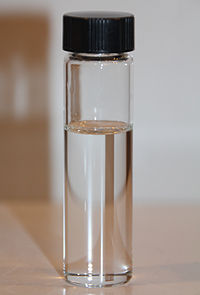Ethylene glycol
|
|
|||
 |
|||
| Names | |||
|---|---|---|---|
|
Preferred IUPAC name
Ethane-1,2-diol
|
|||
| Other names
Ethylene glycol
1,2-Ethanediol Ethylene alcohol Hypodicarbonous acid Monoethylene glycol 1,2-Dihydroxyethane |
|||
| Identifiers | |||
|
107-21-1 |
|||
| 3D model (Jmol) | Interactive image | ||
| 3DMet | B00278 | ||
| Abbreviations | MEG | ||
| 505945 | |||
| ChEBI |
CHEBI:30742 |
||
| ChEMBL |
ChEMBL457299 |
||
| ChemSpider |
13835235 |
||
| ECHA InfoCard | 100.003.159 | ||
| EC Number | 203-473-3 | ||
| 943 | |||
| KEGG |
C01380 |
||
| MeSH | Ethylene+glycol | ||
| PubChem | 174 | ||
| RTECS number | KW2975000 | ||
| UNII |
FC72KVT52F |
||
|
|||
|
|||
| Properties | |||
| C2H6O2 | |||
| Molar mass | 62.07 g·mol−1 | ||
| Appearance | Clear, colorless liquid | ||
| Odor | Odorless | ||
| Density | 1.1132 g/cm3 | ||
| Melting point | −12.9 °C (8.8 °F; 260.2 K) | ||
| Boiling point | 197.3 °C (387.1 °F; 470.4 K) | ||
| Miscible | |||
| Solubility | Soluble in most organic solvents | ||
| Vapor pressure | 0.06 mmHg (20 °C) | ||
| Viscosity | 1.61 × 10−2 N*s / m2 | ||
| Hazards | |||
| Main hazards | Harmful | ||
| Safety data sheet |
See: data page External MSDS |
||
|
EU classification (DSD)
|
Harmful (Xn) | ||
| R-phrases | R22 R36 | ||
| S-phrases | S26 S36 S37 S39 S45 S53 | ||
| NFPA 704 | |||
| Flash point | 111 °C (232 °F; 384 K) closed cup | ||
| 410 °C (770 °F; 683 K) | |||
| Explosive limits | 3.2%-15.2% | ||
| US health exposure limits (NIOSH): | |||
|
PEL (Permissible)
|
None | ||
|
REL (Recommended)
|
None established | ||
|
IDLH (Immediate danger)
|
None | ||
| Related compounds | |||
|
Related diols
|
Propylene glycol Diethylene glycol Triethylene glycol Polyethylene glycol |
||
| Supplementary data page | |||
|
Refractive index (n), Dielectric constant (εr), etc. |
|||
|
Thermodynamic
data |
Phase behaviour solid–liquid–gas |
||
| UV, IR, NMR, MS | |||
|
Except where otherwise noted, data are given for materials in their standard state (at 25 °C [77 °F], 100 kPa).
|
|||
|
|
|||
| Infobox references | |||
Ethylene glycol (IUPAC name: ethane-1,2-diol) is an organic compound with the formula (CH2OH)2. It is mainly used for two purposes, as a raw material in the manufacture of polyester fibers and for antifreeze formulations. It is an odorless, colorless, sweet-tasting syrup. Ethylene glycol is moderately toxic.
Ethylene glycol is produced from ethylene (ethene), via the intermediate ethylene oxide. Ethylene oxide reacts with water to produce ethylene glycol according to the chemical equation:
This reaction can be catalyzed by either acids or bases, or can occur at neutral pH under elevated temperatures. The highest yields of ethylene glycol occur at acidic or neutral pH with a large excess of water. Under these conditions, ethylene glycol yields of 90% can be achieved. The major byproducts are the ethylene glycol oligomers diethylene glycol, triethylene glycol, and tetraethylene glycol. About 6.7 billion kilograms are produced annually.
A higher selectivity is achieved by use of Shell's OMEGA process. In the OMEGA process, the ethylene oxide is first converted with carbon dioxide (CO2) to ethylene carbonate to then react with water in a second step to selectively produce mono-ethylene glycol. The carbon dioxide is released in this step again and can be fed back into the process circuit. The carbon dioxide comes in part from the ethylene oxide production, where a part of the ethylene is completely oxidized.
...
Wikipedia



